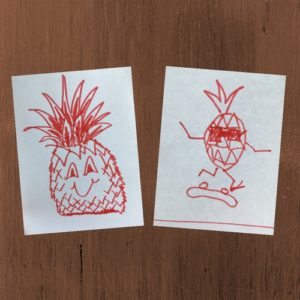In your life’s journey, you may come across a pineapple picture or two. These pineapples may look different, though they are both pineapples. You might immediately have a desire to compare them. When you do, keep this in mind:
How to Compare Pineapples
Artists, writers, athletes, and pretty much anyone who does anything takes a risk. If someone enters a competition, they risk winning and losing. For artists, if they draw/paint/sculpt/design something and share it, they risk judgement.
Artists need to understand not everyone is going to value their artwork the same. Not every color or design will inspire every person. And that’s good – we live in a beautifully diverse world. But today I am speaking to the artist and the viewer of the art. The evaluator. The judge.
How do you compare pineapples?
I drew one of the pineapples in this post, and I got permission from the other artist to share his work today. We drew these pineapples in response to this challenge: draw a pineapple. We came up with very different pictures.
As people compare pineapples, often one of two thoughts can come into our heads:
One pineapple is superior.
~OR~
One pineapple sucks.
I find both of these judgements to do more damage than good. As an artist, if I think my pineapple is superior, I close myself off to learn from the mind, heart, and technique that went into creating the other pineapple. If I think my pineapple sucks, I am devaluing my work and the mind, heart, and technique I put into what I created. The critic faces the same pitfall comparing in that manner.
Instead, try comparing this way:
Value each piece of pineapple artwork respectively.

They are different. One is skateboarding. The other is sitting. One is smooth. The other is pokey. One is wearing shades. The other is smiling.
They are similar. Both pineapples have personality. Both have style. Both pineapples have faces. And they both have spikes on top.
Ask yourself: What is this celebrating? What can I learn from this? Do I want to take something from this picture, and try it when I draw my next pineapple?
Although it may feel elementary, this exercise is one of the most powerful practices both the artist and the critic can apply in life. Because once we learn how to compare our pineapples with value and respect, then can decide how to best use them. Maybe one belongs in a children’s book and the other on a T-shirt.
This is the joy of inventing art together: we can all become our best when we value and learn from our artistic differences.
Happy Inventing!
